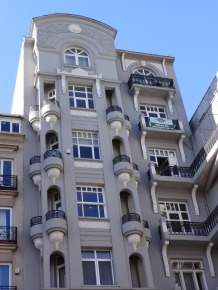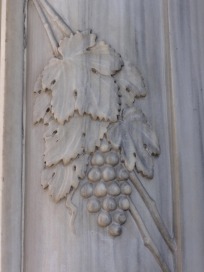“Encouragement”
The swanky suburb of Teşvikiye is the extension of Nişantaşı and it’s not easy to tell exactly where one stops and the other begins. Like Nişantaşı’s Abdi İpekçi Caddesi, Teşvikiye Caddesi is lined with shops selling brand-name goods although it’s also home to the City’s Shopping Mall which rises to more mundane shops as well as one of İstanbul’s Apple franchise shops if you need an urgent repair to your Mac.
The most interesting historic monument in Teşvikiye is Teşvikiye Cami which often provides the setting for high-society funerals. Not far past it Teşvikiye segues into Maçka and heads on downhill to Maçka Demokrasi Park.
Backstory
Right into the 19th century this was a sparsely developed part of the city. Then Sultan Mahmud II set about encouraging people to settle there. Later it became associated with a group of Turks called the Dönme (Converts), descendants of the followers of Sabetay Sevi, a Smyrna Jew who had proclaimed himself the Messiah, only to change his mind and convert to Islam. He and his followers were exiled to Thessaloniki in Greece which might have been the end of the story as far as Turkey was concerned except that after the 1923 Graeco-Turkish population exchange these Muslims were “returned” to Turkey. Many of them chose to settle in Teşvikiye. Abdi İpekçi, for example, was a Dönme, as, I believe, was politician İsmail Cem.
Around Teşvikiye
Teşviiye Caddesi is an extension of Rumeli Caddesi which runs down from the Osmanbey Metro station. It changes name at the crossroads marked by one of the nişantaşı (marker stones) that recorded the distances reached by arrows shot by the later sultans. There’s another one in the grounds of the stone-built early 20th-century Teşvikiye Police Station at the next road junction down (more can be seen in the Okmeydanı complex).
Further down the road on the opposite side, the delicate Teşvikiye Cami dates back only to 1853 although there had been an earlier mosque on the same site. An architecturally simple building, it has an elegant marble entrance with the sultan’s tuğra (signature) on its parapet. The solitary dome and minaret show how far Ottoman architecture had retreated from the elaboration of the Sinan years.
The mosque grounds provide a home for two more nişantaşıs, one marking a record set by Sultan Selim III, the other by Sultan Mahmud II. On the street outside the muvakkitane (time-keeper’s house) that was part of the mosque complex has now been coopted to house a restaurant.
 Facing the mosque the lovely Teşvikiye Palas apartment block was designed in the 1930s and used to house the Mexican Embassy. As you turn down Maçka Caddesi the Narmanlı Apartment block is even finer with bunches of grapes carved on the stone doorframe.
Facing the mosque the lovely Teşvikiye Palas apartment block was designed in the 1930s and used to house the Mexican Embassy. As you turn down Maçka Caddesi the Narmanlı Apartment block is even finer with bunches of grapes carved on the stone doorframe.
Ahmet Fetgarı Sokak behind the mosque is home to a number of inviting small cafes and art galleries.
 Eating
Eating
The House Cafe This small restaurant is partially housed inside the circular building that was once the muvakkitane of the mosque. It’s reliable fusion menu includes some delightful mini pizzas including one topped with mushrooms and pears. Tel: 0212- 327 1774
Sleeping
Stay Boulevard Nişantaşı. Tel: 0212-970 7838
Transport info
Probably the nicest way to get to Teşvikiye is to take the cable-car from near Taksim Square (the entrance is in the park just past the Taşkışla (Stone Barracks)) to Maçka and then walk uphill.
Dolmuşes to Nişantaşı run from the Eminönü waterfront and leave you near the City’s shopping mall, a short walk away from Teşvikiye.
Alternatively you can take the Metro to Osmanbey and walk down Rumeli Caddesi to get there.
Nearby areas


